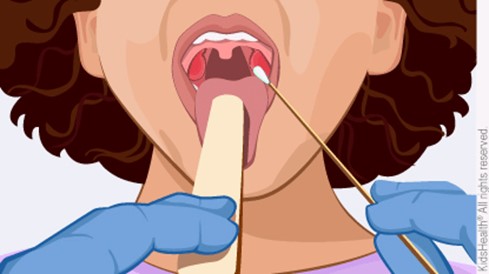Which instructions should a nurse give to a client prior to obtaining a throat culture?
“While depressing your tongue, I will swab the back of your throat.”.
“You won’t be able to eat or drink for one hour after the procedure.”.
“Take a deep breath and then cough while I swab your throat.”.
“I just need to swab your anterior tongue. It will be very quick.”.
The Correct Answer is A
This is the proper way to obtain a throat culture, which is a test to look for infections in the back of the throat.

Some possible explanations for the other choices are:
Choice B is wrong because there is no need to avoid eating or drinking after a throat culture.
The swab does not interfere with the normal function of the mouth or throat.
Choice C is wrong because coughing while swabbing the throat could contaminate the sample or cause discomfort to the client. The swab should be gently passed along the back area of the throat and tonsils.
Choice D is wrong because swabbing only the anterior tongue would not collect enough cells from the infected area. The swab should reach the back of the throat where bacteria or fungi may grow.
Nursing Test Bank
Naxlex Comprehensive Predictor Exams
Related Questions
Correct Answer is C
Explanation
This is because restraints should only be used as a last resort when other alternatives have failed to ensure the patient’s safety and when there is a valid order from the primary healthcare provider.
Assessing the need for restraints placement involves evaluating the patient’s condition, behavior, risk factors, and potential benefits and harms of using restraints.
Choice A is wrong because visual inspection of skin for placement is done after applying restraints, not before.
This is to check for any signs of injury, irritation, or circulation impairment caused by the restraints.
Choice B is wrong because positioning for proper body alignment is done during and after applying restraints, not before.
This is to prevent complications such as pressure ulcers, contractures, or nerve damage due to improper positioning.
Choice D is wrong because reviewing facility policy before usage is not a nursing intervention, but a legal and ethical requirement.
Nurses should be familiar with the facility policy and guidelines regarding the use of restraints and follow them accordingly.
However, this does not replace the need for individualized assessment and evaluation of each patient’s situation.
Correct Answer is B
Explanation
This is the appropriate action because it prevents the spread of infection and maintains a clean environment.
The nurse should also wear gloves and dispose of the bag properly.
Choice A is wrong because saturating the dressing with saline before removing it can cause maceration of the skin and increase the risk of infection. The dressing should be removed gently and carefully, and if it is adhered to the wound, small amounts of sterile saline can be used to loosen it.
Choice C is wrong because using the old dressing to debride any tissue that is adhered to the wound can cause trauma, bleeding, and pain. The nurse should use sterile forceps or cotton- tipped applicators to gently press moistened gauze into the wound surfaces.
Choice D is wrong because reinserting the drain if removed with the dressing can cause injury and infection. The nurse should notify the surgeon immediately if the drain is accidentally removed.
Whether you are a student looking to ace your exams or a practicing nurse seeking to enhance your expertise , our nursing education contents will empower you with the confidence and competence to make a difference in the lives of patients and become a respected leader in the healthcare field.
Visit Naxlex, invest in your future and unlock endless possibilities with our unparalleled nursing education contents today
Report Wrong Answer on the Current Question
Do you disagree with the answer? If yes, what is your expected answer? Explain.
Kindly be descriptive with the issue you are facing.
